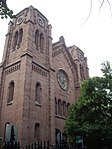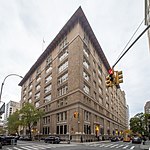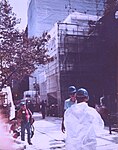Scheffel Hall

Scheffel Hall at 190 Third Avenue in the Gramercy Park neighborhood of Manhattan, New York City, was built in 1894–1895, and designed by Henry Adams Weber and Hubert Drosser, at a time when the area south of it was known as Kleindeutschland ("Little Germany") due to the large number of German immigrants who lived nearby. The building, which served as a beer hall and restaurant, was modeled after an early 17th-century building in Heidelberg Castle, the "Friedrichsbau", and was named after Joseph Viktor von Scheffel, a German poet and novelist. It later became known as Allaire's, a name still inscribed on the building. The building's style has been described as "German-American eclectic Renaissance Revival".Later, in the late 1920s, the building was used by the German-American Athletic Club. By 1939 it became the German-American Rathskeller, and then Joe King's Rathskeller. O. Henry used Scheffel Hall as the setting for "The Halberdier of the Little Rheinschloss" and wrote some of his stories there. Beginning in the 1970s, it was the home of Fat Tuesday's, a well-known jazz club, and the restaurant Tuesday's, which lasted until the early 21st century. It is currently a yoga and pilates studio. Update: as of late August 2020 the building is for rent. Sal Anthony, who had his movement studio here, has died. This is a glorious example of 19th century architecture. Scheffel Hall was designated a New York City landmark in 1997.
Excerpt from the Wikipedia article Scheffel Hall (License: CC BY-SA 3.0, Authors, Images).Scheffel Hall
3rd Avenue, New York Manhattan
Geographical coordinates (GPS) Address Nearby Places Show on map
Geographical coordinates (GPS)
| Latitude | Longitude |
|---|---|
| N 40.73545 ° | E -73.985818 ° |
Address
3rd Avenue 190
10003 New York, Manhattan
New York, United States
Open on Google Maps








